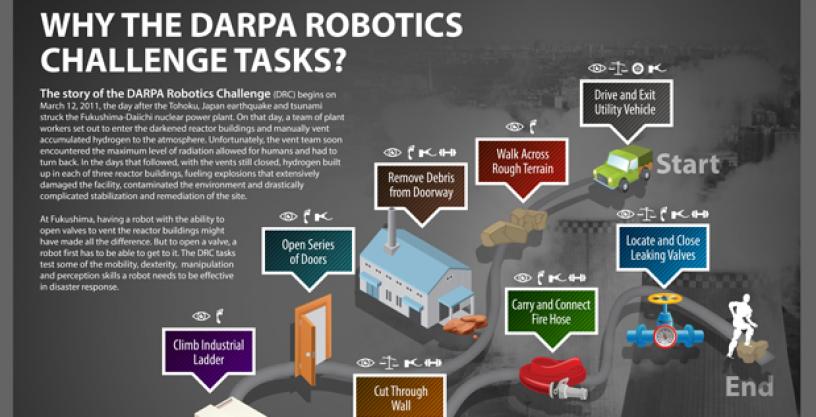
Eight tasks are designed to be challenging, as teams’ prototype robots take ‘baby steps’ toward future capabilities
Dec 16, 2013
The DARPA Robotics Challenge (DRC) Trials—taking place December 20-21 at the Homestead-Miami Speedway in Homestead, Fla.—aim to speed development of robots that could aid in response efforts after future natural and man-made disasters. The teams competing at the DRC Trials will direct their prototype robots to accomplish eight tasks, each designed to test the robots’ ability to perform a number of critical real-world disaster-response skills. Through the tasks, DARPA seeks to determine the robots’ ability to act semi-autonomously, instead of through tele-operation, by deliberately varying communications speeds between the robots and their operators.
DARPA designed the tasks to simulate what a future robot might have to do to safely enter and effectively work inside a disaster zone. They will test the robots’ autonomous perception, autonomous decision-making, mounted and dismounted mobility, dexterity and strength. Each team will receive a score based on its performance, with all eight tasks carrying equal weight. Up to eight teams with the highest scores may continue to receive DARPA funding to prepare for the DRC Finals scheduled for late 2014.
Each task presents distinct challenges for the robots and their operators:
Drive and Exit Utility Vehicle: The hardest single task and the one that requires the most robot-human interaction. The operators must direct the robots to drive the vehicle safely despite occasional communications disruptions. Getting out of the driver’s seat poses significant strength and dexterity challenges for the robots.
Walk Across Rough Terrain: The robots must maintain their balance and identify safe routes for placement of limbs.
Remove Debris from Doorway: Robots must demonstrate a wide range of motion, in addition to balance and strength, to clear a path forward.
Open Series of Doors: Moving the doors in an arc challenges the robots’ perception and dexterity. The robots must figure out how to align and move themselves as they open each door.
Climb Industrial Ladder: To avoid falls, the robots must safely navigate the ladder and maintain their balance as they climb. Strength is required to stop a fall.
Cut Through Wall: Using power tools tests the robots’ strength, dexterity and ability to perceive their environment. The robots must also simultaneously apply rigid force to hold a tool, yet demonstrate the flexibility to smoothly manipulate it.
Carry and Connect Fire Hose: The robots must identify the standpipe and then transport a bulky, non-rigid item (the fire hose) to it. The robots must then have sufficient dexterity and strength to attach the hose to a standpipe and open the spigot.
Locate and Close Leaking Valves: The robots must identify the valves, determine which ones are open and have sufficient range of motion to turn the valve wheels in an arc to close them.
Because the robots are still so early in their development, DARPA is providing the robots with 30 minutes to perform each task. Each team will attempt to complete each task once over the course of the two-day event. It is expected, however, that not all of the teams will finish every task.
“We know the robots are slow and unsteady at this point—they’re much like a one-year-old human in terms of locomotion and grasping abilities and much farther behind that in brainpower,” said Gill Pratt, DARPA program manager. “The robots are taking ‘baby steps’ this year, but their performance will establish a reference point for what we can expect from the teams that return next year for the DRC Finals. We want that event to be much more difficult and force the robots to demonstrate useful capabilities in realistic disaster scenarios.”
Realism is at the heart of the DRC Trials’ tasks. During the March 2011 Fukushima nuclear meltdown, which inspired DARPA to create the DRC, lethal radiation levels prevented human responders from entering the facility and turning a valve that could have vented hydrogen. The hydrogen eventually exploded, devastating the facility and surrounding area. If sufficiently advanced robots had been on hand, they might have performed actions similar to those the DRC Trials are testing and averted disaster.
The DRC Trials are free and open to the public and media. In addition to the competition, the onsite DRC Exposition will showcase technology related to disaster response, robotics and autonomy. It will include, among others, demonstrations of DARPA’s “Wild Cat” (an untethered, all-terrain version of the “Cheetah” robot), Legged Squad Support System (LS3) and Warrior Web program.
# # #
Associated images posted on www.darpa.mil and video posted at www.youtube.com/darpatv may be reused according to the terms of the DARPA User Agreement, available here: http://www.darpa.mil/policy/usage-policy.
Tweet @darpa
